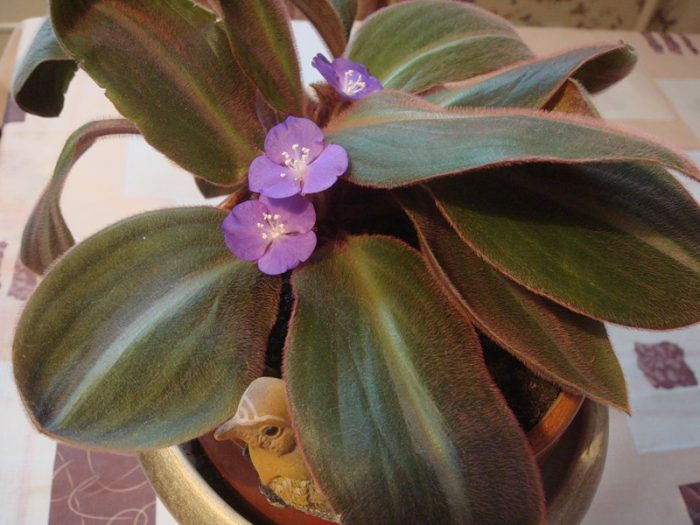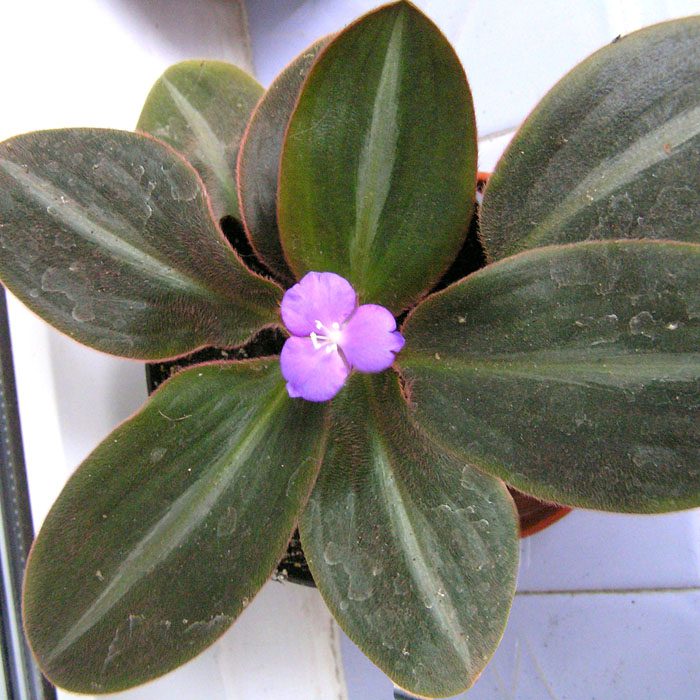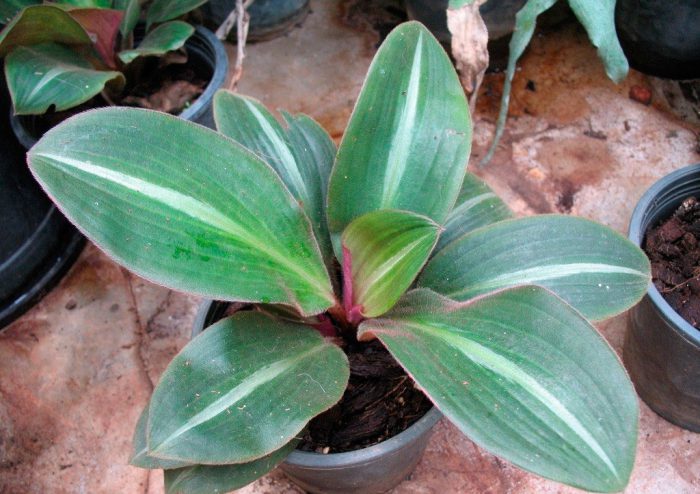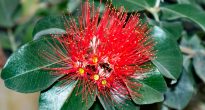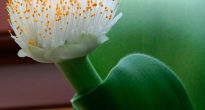Kind of like siderasis, belonging to the Commelinaceae family, has only one representative, namely, brown siderasis (Siderasis fuscata). In nature, it can be found in the forests of eastern Brazil.
This herbaceous perennial plant can grow to a height of 30-40 centimeters. It has a very short stem and a dense rosette of leaves. The leaves are large enough and very fleshy. Simple leaves are elliptical in shape, their width is about 10 centimeters, and their length is 20 centimeters. The glossy front side of the leaves is colored dark green and there is a silvery, pale green longitudinal stripe right in the center. The seamy side is painted greenish purple.
The small flowers (approximately 2.5 centimeters in diameter) are purple-lilac and have snow-white stamens. Also, flowers with 3 petals are collected in not very large apical inflorescences-curls. Flowers are attached to thick, not long (3-4 centimeters) peduncles. The plant blooms in May-October.
Spectacular pubescence gives a special decorative effect to siderasis. Almost all parts of the flower are covered with a dense layer of short purple hairs. It is thanks to this feature that the plant got its second name - "bear ears".
Content
Caring for siderasis at home
This flower is very rarely seen in someone's apartment, and it is also rarely found in flower shops. Siderasis is a very exotic plant, and its happy owners should definitely learn how to properly care for it.
Illumination
Diffused light is required, and the illumination should be at the level of 2500-2700 lux. It grows and develops quite well in partial shade, and also feels great under artificial lighting and can do without the light of the sun in this case.
For this plant, it is best to choose the sill of the window located in the northern part of the room. If it has to be placed in the southern part, then it is recommended to remove the siderasis away from the window opening.
Temperature regime
In the warm season, it feels good at moderate temperatures (22-25 degrees). With the onset of winter, you can rearrange the flower in a cool place (from 14 to 16 degrees). However, the temperature should not drop below 14 degrees, because the delicate foliage will freeze.
How to water
Watering is carried out as the substrate dries.For this, be sure to use soft, settled water. In no case should the liquid get on the foliage. Experienced growers advise watering through the pallet. To do this, pour water into a wide pan and put a pot. After a while, the remaining liquid must be poured out. Thus, it is especially recommended to water adult, overgrown plants.
Water stagnation in the soil should not be allowed, as the plant will begin to rot. The drying out of the soil substrate can also be destructive, because the weak roots do not accumulate moisture in reserve, and as a result, the flower dries quickly.
Humidity
A high humidity of at least 70 percent is required. However, foliar spraying is unacceptable. In order to make the humidity high, you can pour a little expanded clay into the pan and pour in water. Also, in the immediate vicinity of the siderasis, you can put an open vessel filled with water. However, terrariums or florariums are best suited for growing it. This is where the flower will feel best.
Earth mix
Suitable soil should be loose and nutrient-dense. You can make a do-it-yourself soil mixture by mixing humus and leafy soil, as well as coarse sand in a 1: 2: 1 ratio. Don't forget to have a good drainage layer to help prevent overflow.
Fertilizers
Top dressing is required only during active plant growth 2 times a month. For this, complex mineral fertilizers are used for decorative deciduous plants. With the onset of the autumn period, they are fed less often, and in the winter time, fertilizers are not applied to the soil.
Transplant features
Regular transplants are not required to the plant, as it grows rather slowly. As a rule, this procedure is carried out only after the roots cease to be placed in the pot. For transplanting, you need to take a flower pot a little wider than the previous one, but at the same time it should be low.
Pruning
Need not.
Reproduction methods
As a rule, they are propagated by division. To do this, during transplantation, the rhizome is carefully cut into pieces. It is extremely difficult to grow from seeds, and seedlings often die. Cuttings are also not suitable for reproduction.
Diseases and pests
Most often settles on the plant spider mite... It is very difficult to get rid of this harmful insect, since the leaves cannot be moistened. However, there is one rather effective folk way. Siderasis should be tightly covered with a polyethylene bag, and inside it should be laid out balls of cotton wool soaked in dichlorvos (they cannot be put on foliage or the ground).
It is practically not susceptible to diseases, but at the same time, if you take care of it incorrectly, this can lead to a loss of decorativeness, as well as to the death of the plant. So, it is impossible to prevent overflow or overdrying of the substrate. Also, if there is low humidity, the tips of the leaves will begin to dry out. The plant will lose its decorative effect for a long time, as new foliage grows very slowly.

